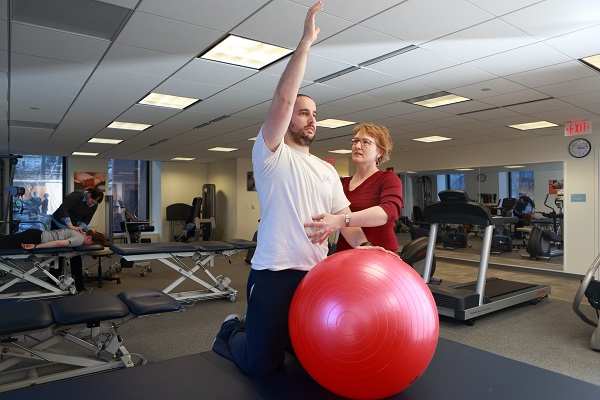Faculty Expert Shares Working at Home Stretching Tips
April 30, 2020
There are many accommodations we've have to make to continue "business as usual" during this life-altering COVID-19 health crisis. In addition to developing work schedules in the midst of teaching kids school lessons or keeping younger children occupied, we've had to carve out a location where we can be productive. All of these things bring added stress to the mind and the body in ways that we may not yet know.
 The CNHP community are direct beneficiaries of our faculty and research experts who have the unique ability to bring calm and understanding to this volatile and anxiety-producing situation. We called upon Sara Tomaszewski, PT, DPT, an assistant clinical professor in the Department of Physical Therapy and Rehabilitation Sciences, to lend her knowledge of the musculoskeletal system with those who may have new physical health complaints. Because she provides patient care at Drexel's clinic locations, Tomaszewski is the perfect person to ask to provide tips for coping with body aches and pains associated with makeshift workstations we've created at home during this pandemic.
The CNHP community are direct beneficiaries of our faculty and research experts who have the unique ability to bring calm and understanding to this volatile and anxiety-producing situation. We called upon Sara Tomaszewski, PT, DPT, an assistant clinical professor in the Department of Physical Therapy and Rehabilitation Sciences, to lend her knowledge of the musculoskeletal system with those who may have new physical health complaints. Because she provides patient care at Drexel's clinic locations, Tomaszewski is the perfect person to ask to provide tips for coping with body aches and pains associated with makeshift workstations we've created at home during this pandemic.
"We all know we should take breaks, but this can be more challenging when we’re not in our usual environment, and even more challenging if we’re not working at our usual ergonomic work set up," Tomaszewski notes.
Tomaszewski's solution for neck, shoulder and back pain, and even headaches caused by prolonged posture on the phone or doing computer work is the “5-for-5” routine. She shared that these are some easy stretches to maintain mobility in your neck, shoulders, and back, that takes less than two minutes to do.
- Shoulder circles: Shrug your shoulders all the way up towards your ears, then squeeze them back as if pinching your shoulder blades together, then drop them all the way down. Repeat 5 times.
- Chin tucks: Sit up straight with your shoulders relaxed down from the shoulder circles. Pull your chin back to make a double chin – as if you’re pulling your face away from something that smells bad. Maintain good alignment by keeping your eyes forward and keeping your nose parallel to the floor. This should create a good stretch along the back of your head and neck. Hold 5 seconds and repeat 5 times.
- Neck side bending: Sitting up straight, gently bend your neck to one side as if bringing your ear to you shoulder. You should feel a gentle stretch on the opposite side of your neck. Hold 5 seconds, then repeat on the opposite side.
- Trunk twists: Sitting up tall in your chair one last time, wrap your arms around yourself as if giving yourself a hug. Then gently twist to one side as far as you can, to stretch your mid-back and shoulder blade muscles. Hold 5 seconds, then repeat on the opposite side.
- Deep diaphragmatic breath: Now that your muscles are loose, take a deep breath in over a count of five, pushing your belly out and really filling your lungs. Then breathe out slowly over a count of 5, feeling the tension and stress leaving your body, and relaxing any muscles that might be holding tension.
Tomaszewski suggested that trying them once an hour is a great way to prevent tightness from setting in.
If you are experiencing challenges beyond these common issues, help is available through our physical therapy practices online appointments. "Telehealth is not new to PT," explained Tomaszewski, “and we are excited to implement it as part of the services our clinical practice offers." Past restrictions with referrals and insurance precluded new patients from seeking telehealth physical therapy appointments, but Tomaszewski disclosed that those constraints have been loosened. "After our physical practice location at the Drexel University Recreation Center closed due to the pandemic, we continued seeing some existing patients who have chosen to try telehealth PT. And now, we are able to do virtual assessments and provide interventions to new patients, even without a doctor's referral," she added.
Tomaszewski recommended calling 215-571-4287 or emailing ptappts@drexel.edu for more information or to schedule a consultation. "We are eager and ready to continue providing exceptional care for the Drexel University faculty, staff and student population now, during this stay-at-home order, and after we return to campus," she concluded.
